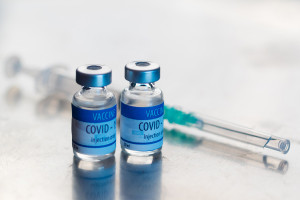Rutgers Engineers Are Developing a Breathalyzer Test for COVID-19
The fast-acting sensor is designed to identify the presence of SARS-CoV-2 from exhaled breath in 10 minutes.

Researchers at Rutgers are working to develop a COVID-19 breathalyzer test. Photograph by
Malorny/Getty Images
As vaccines continue to be administered and restrictions ease across the country, researchers are not resting when it comes to developing novel technologies for our coronavirus-impacted lives, from an “antibody cocktail” to a rapid test for variants. One of the latest COVID-19 devices currently in the works comes from Rutgers University: a fast-acting breathalyzer test that can detect the presence of SARS-CoV-2 in 10 minutes.
The test, which is funded through the National Institutes of Health (NIH) Rapid Acceleration of Diagnostics and Rutgers’ HealthAdvance programs, is designed to collect aerosol particles exhaled from a person’s breath — droplets that contribute to the spread of SARS-CoV-2 — and deposit them into an electronic biosensor for rapid results, according to Rutgers. The application, they say, has the potential to not only circumvent the physical discomforts associated with nasopharyngeal testing, but to increase large-scale testing everywhere.
We spoke with Edward DeMauro, principal investigator and assistant professor of mechanical and aerospace engineering at Rutgers University, about how the test is being developed and what impact it might have both now and in the future.
NextHealth: When and why did your team begin developing this test?
DeMauro: We — myself, German Drazer, Hao Lin, and Mehdi Javanmard — began designing the test early last summer, and are still in the development process. One of the things that the three of us in mechanical and aerospace [DeMauro, Drazer, and Lin] have been working on for the past couple of years is how to purify a flow of air by capturing small-scale particles. Meanwhile, Mehdi Javanmard from electrical was working on developing a sensor that is capable of detecting the presence of proteins from exhaled breath. Those factors combined allowed our concept for the test we’re working on now to develop pretty much immediately, as we realized independently from the existence of COVID-19 that we could take these two pieces of technology and use it for sampling [of various particles]. In this way, we formed our team specifically for developing some type of sensor.
Then COVID-19 hit, and we saw an opportunity to take our different technologies that we had been developing pre-pandemic and refine their specific applications to the problem of improved testing for the presence of SARS-CoV-2. One opportunity we found immediately was to tackle the problem of increasing the levels of testing of aerosol particles from a person’s breath because they are the droplets that would spread infection.
[Note: Rutgers adds that the development of the breathalyzer is based on a device that now collects and removes samples of industrial contaminants from the air. This filter, in conjunction with the new electronic sensor being developed for detecting different types of proteins in bodily fluids, would be able to detect the coronavirus.]
And it works like a traditional breathalyzer?
The intention is you blow into the device with little to no exertion. Then, it will register the presence of virus. Currently, it can produce results in up to 10 minutes. We’ve had students working with us to identify the average output speeds and pressures associated with a person’s breathing because we don’t want it to be physically demanding or uncomfortable for the user.
What’s the next phase in the process?
In January of this year, we received a two-year grant from NIH, which ends December 2022. We’re in the process right now of performing simulations and optimizations of our device, as well as building working prototypes for additional testing. Our colleagues are assessing the length of detection of the sensing element. By the end of 2021, the expectation is that individual elements will be fully fleshed out on their own and defined. By the end of next calendar year, we hope to demonstrate the ability of our completed device to detect the presence of protein markers associated with COVID-19 in a table-top simulated experiment.
The end of next year is a long time away, especially when people are eager to return to life that resembles pre-COVID times.
We’re talking about development of a product that we’re hoping to have finished after the pandemic. But if there’s one truth we learned in the past year, it’s that we need to make sure we’re prepared for the next pandemic. Once this pandemic ends, it’s important that we don’t relax and start thinking that this [or something similar] won’t ever happen again. So the nature of this project is to not only develop a sensor for SARS-CoV-2, but to fund the development of technologies and devices that can be easily reconfigurable for other respiratory illnesses, like the flu, and other infectious diseases that may emerge in the future.


